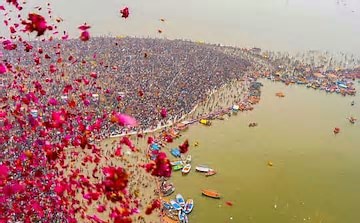Spiritually, taking dips in the holy water of the sacred rivers is believed to provide liberation, which is the ultimate purpose of the followers of Sanatan Dharma.
Followers of Sanatan Dharma consider the Maha Kumbh (Great Kumbh) to be one of the most auspicious festivals, drawing the largest gathering worldwide. This religious festival, Kumbh Mela, is celebrated four times in 12 years every 4 years, with the largest one, Maha Kumbh, celebrated once in 144 years. The sites of these events are Haridwar on the River Ganga, Ujjain on the River Shipra, Nashik on the River Godavari, and the confluence of Rivers Ganga, Yamuna, and mythical Saraswati in Prayagraj. In 2025, the Maha Kumbh is slated to begin in Prayagraj on January 13, 2025, with the Pausha Purnima Snan, and conclude on February 26, 2025, with the Shahi Snan, corresponding with Maha Shivaratri.
The scientific and astrological basis of Kumbh and Maha-Kumbh lies in the alignment of the planets. The Haridwar Kumbh is celebrated when Jupiter is in Aquarius and the Sun is in Aries symbolizing the renewal of life. The Prayagraj Kumbh is held when Jupiter is in Taurus and Sun and Moon are in Capricorn, signifying a balance between spiritual and material pursuits. The Ujjain Kumbh is organized when Jupiter is in Leo, symbolizing the building of strength. The Nashik Kumbh is commemorated when Jupiter is in Leo and the Sun is in Virgo signifying purification and healing. A research article published in the journal, Environmental Monitoring and Assessment, after the Kumbh Mela in 2013, found that the number of bacteriophages (that consume bacteria and regulate their growth) increased during Kumbh in River Ganga thus aiding in the self-cleansing of this River and provided some scientific credibility to this event. Culturally, the Kumbh Mela is deeply rooted in Indian culture. It is significant to all followers of Sanatan Dharma and even Sikhism. It is a symbol of faith and hardships that one endures to visit this pilgrimage. It is a vibrant demonstration of the rich tapestry of culture in India which many Westerners come to witness. It has many things to offer such as spiritual discourses, artisanal fairs, and cultural performances.
Records of this bathing pilgrimage can be traced back to the Rig Veda. In the Mahabharat also this pilgrimage is mentioned to atone for past mistakes (prayaschita). Chinese Buddhist pilgrim, Hiuan Tsang (Yuan Chwang), who came to India in 630 A.D. also mentions the Kumbh Mela. Likewise, accounts of organizing this during the Mughal Empire and British rule have been documented by historians. During British rule, the British imposed a “pilgrim tax” as a source of revenue and missionaries saw it as an opportunity to propagate Christianity. After independence, the Kumbh Mela has been systematically organized.
Kumbh Mela is one of the largest gatherings on the planet and according to the Medical Journal, Armed Forces India, in 2013 when it was held, 120 million pilgrims visited it. It poses numerous challenges to the healthcare system. For the 2025 Maha Kumbh, a lot of preparations have gone in, and infrastructure has been boosted to prevent the spread of infectious diseases and provide a safe, comfortable environment for the pilgrims.
Spiritually, participation and taking dips in the holy water of the sacred rivers is believed to provide liberation which is the ultimate purpose of followers of Sanatan Dharma. A multitude of saints, mystics, and ascetics from various parts of India gather and offer their prayers to the Almighty while delivering discourses on religion and spirituality. There are 13 camps or akharas that are organized during Kumbh Mela. Ten belong to Sanatan Dharma followers (7 Shaiva and 3 Vaishnava) and 3 to Sikhism followers. The vibrations of so many devoted pilgrims at the same time generate an aura of bliss that is easily palpable.
* Dr Manoj Sharma is a Professor and Chair of the Department of Social and Behavioral Health at the University of Nevada, Las Vegas, USA. He is an avid practitioner of Kundalini Yoga.

